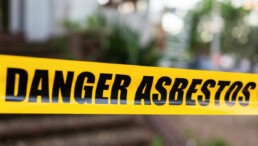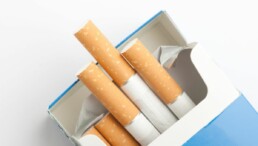The holidays can be a time of contrasts: chaos and contemplation, stress and relaxation, consumption and giving, excess for some and scarcity for others.
In the spirit of balance, we at Shepard O’Donnell want to wish you the happiest of holidays and also warn you of some of the hidden dangers that can be lurking where you least expect them.
You might not be surprised that we urge caution when taking decorations out of your great-grandmother’s attic: older attics may still contain asbestos insulation and rustling around up there can disturb fibers and dust that you might then bring down into your living space.
But you may be quite surprised to learn that asbestos might be hiding in some of the vintage wine you are saving for a special occasion! While it’s now illegal, asbestos was used in wine filtration systems across the industry up to the 1970s. Experts say that asbestos fibers are less likely to be found in finer, more expensive wines and that it is relatively rare that you still find wine contaminated with asbestos today.
Although many of the following items no longer pose an imminent threat, we wanted to share a few holiday-related products in which you might find lingering asbestos:
Fake Snow
The ideal of a “white Christmas” has been around for decades, popularized by countless movies and songs, and many people wanted to bring that beauty inside. White asbestos, or chrysotile, has a fluffy texture and was once sold as fake snow. People could buy packs of chrysotile, marketed under names like Snow Drift and Pure White, to create festive snowy scenes at home! Unbelievably, the company that made these products advertised them as “safe snow for holiday decorations,” and many people used it to create wintery scenes or flock the Christmas tree.
Sadly, even Hollywood fell for this misguided advice: The classic film, The Wizard of Oz, used 100% asbestos for the snow that rained down on Dorothy and her friends, and others like Holiday Inn and It’s a Wonderful Life also used it for their snow scenes.
Vintage Ornaments
Vintage ornaments and other decorations that have a look of frost or snow were probably also made from asbestos. If you’ve inherited decorations from older relatives or purchased them at an antique store, check closely for that telltale dusting of white.
Model Train Sets
The “snow” was also commonly thrown around toy train sets that circled the Christmas tree or even in the elaborate model railway layouts that may have been set up in your grandfather’s basement. Some modelers also used powdered asbestos, dyed green, as ground cover and it was also often found in plaster.
Old Holiday Lights
Because asbestos was prized for its fire-resistant qualities, old string lights and wires were often insulated with this material. Be very careful when handling these items, especially if you notice any damage.
Artificial Fireplace Ash
Artificial ash made out of asbestos was often used in private homes to create a fake glow in artificial fireplaces before it was banned in 1977. Needless to say, this ash was readily breathed in and posed a real danger to people looking to create a warm ambience during the cold winter months.
Household Fabrics
Again, the fire-resistant properties of asbestos made it “ideal” for fabrics that might potentially catch fire during normal use, such as oven mitts, tablecloths, mats, and even Christmas tree skirts. Many such products manufactured in the early part of the 20th century were made with asbestos.
Children’s Pajamas
In a misguided attempt to keep children safe, clothing manufacturers made kid’s pajamas with flame-retardant materials containing asbestos. These were not banned until the 1970s!
Older Household Appliances
Crock pots, toasters, ovens, irons, coffee pots, bottle warmers, popcorn poppers, hair dryers and more used asbestos as insulating material, either to keep their outsides cool, their contents warm, or to insulate their wires. Today, these products don’t pose too much exposure risk to users unless they have damage.
Curtains
Asbestos curtains first became popular in movie theaters, where the large stage curtain was at risk of catching fire due to the close proximity of hot stage lights. Asbestos curtains were also marketed to homeowners for their fire-resistance and sound insulation benefits and could be found in luxury homes built before 1980.
Books
The binding of some old books, even those bound as late as the mid 1900s, have been found to contain asbestos. Most famously, the first editions of Fahrenheit 451 by Ray Bradbury (a novel in which books were banned and any that were found were burned) were released with fire-proof asbestos binding.
Crayons
As late as 2015, Disney- and Nickelodeon-branded crayons depicting Mickey Mouse, Teenage Mutant Ninja Turtles and Power Rangers, were found to contain traces of asbestos. Manufactured in China, these crayons were ultimately recalled and most were disposed of professionally.
Modeling Clay
A Milton Bradley product called Fibro-Clay was a powdery substance used to make paper mache. This product was found to contain asbestos and wasn’t recalled by the Consumer Product Safety Commission until 1983.
Toy “CSI” Crime Scene Kits
These popular toys, based on the ubiquitous TV shows of the same name and sold at Toys ‘R’ Us and other common retailers, were found to contain asbestos in the fingerprinting powder. When dusting for prints and blowing the dust away, children could inhale enough asbestos to cause cancer later in life, according to an Environmental Working Group report in 2007.
Children’s Makeup
Cosmetics and other personal products made with talc are gaining notoriety because talc is frequently contaminated with asbestos fibers. Especially troubling is that asbestos has been found in children’s makeup, including eye shadows and powders, sold by Claire’s and Justice stores as recently as 2020.
Model Airplane Heat Guns
T/F Monokote heat guns used by model airplane hobbyists contained asbestos in the heat shields, and asbestos fibers were released with each use. This product was recalled by the Consumer Product Safety Commission in 1980.
At Shepard O’Donnell, we wish everyone to enjoy a safe and happy holiday season, free from hazards and harm.








